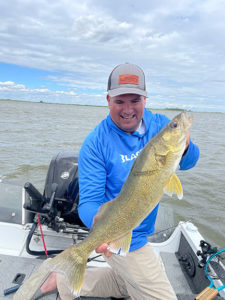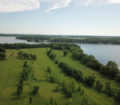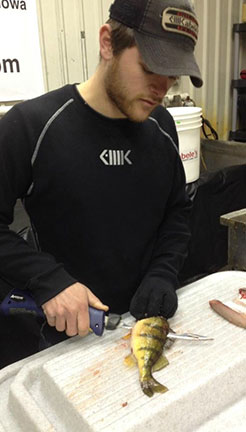
(photo submitted) With bottom bouncers, don’t be afraid to put the rods in the rod holder and go. The forward momentum of the boat often hooks up fish and we often hook up more fish by simply dragging the fish with the boat on the initial strike particularly later in the summer when the water warms up.
By Jason Mitchell
Bottom bouncers are so incredibly effective in mid to late summer for walleye on most fisheries. Would dare argue that this program might be the easiest way to catch walleye once fish start relating to deep contours, main lake structure and primary points. What makes the bouncer so effective is that the wire will walk your snell or spinner harness over rock and keep the presentation near the bottom although you can troll bottom bouncers off the bottom with consistent speed and a line counter reel. You can also cover water and fish bottom bouncers much faster than a traditional live bait rig. You can move until you find fish and finding the fish is the name of the game most days on the water. Below are our top ten tips for catching more walleye with bottom bouncers this summer.
Get the lead out
Choosing the right size bottom bouncer is important. Match the weight of the bottom bouncer with the speed and depth you are fishing. As a rule of thumb, use one ounce of bottom bouncer for every ten feet of water. If you are in ten feet of water, use a one-ounce bottom bouncer. If you are in twenty-five feet of water, bump up to a two-ounce bottom bouncer. This rule of thumb will handle most general speeds that range from .7 to 1.4 miles per hour. If you do want to burn spinner harnesses faster, or are in extremely snaggy rock, don’t be afraid to cheat this rule and run heavier bouncers as close to the boat as possible.
Fishing at a forty-five
As a rule of thumb, you don’t want to let out unnecessary amounts of line to find bottom. Keep the bottom bouncer as close to the boat as possible so that the bouncer stays upright and walks over snags. A good rule of thumb is to run your lines at about a forty-five-degree angle below the boat.
Rod holder vs. hand holding
Early in the summer, we often find more success by holding onto the rod and dropping the rod tip back momentarily when a fish bites to feed the fish. As we get into mid to late summer, don’t be afraid to use your rod holders and keep moving forward as a fish strikes. Almost seems like aggressive fish in warmer water want the presentation getting pulled away even when they strike and are hanging on the bait. You will see the strike on the rod tip. Don’t stop or slow down, just wait for the rod to load up from the fish and set the hook with the forward momentum of the boat. This is what makes the presentation so easy and great for new anglers or young anglers. Pick the rod up out of the rod holder and reel in the fish.
Spinners vs. snells
Many anglers use spinners or some type of spinner/ crawler harness come mid-summer. The vibration and flash attracts fish. Favorite spinner harnesses include the Northland Rainbow or Baitfish series. The spinner is a great tool for fishing faster to find aggressive fish. Also shines in turbid or dirty water or when fishing in wind. There are times however where less can be more. Plain snells can also work well behind bottom bouncers especially mid-day or during flat calm conditions. Snells with a small float or bead like the PK Wobbler can lift the presentation off the bottom and add some subtle color and attraction. Half crawler rigs like Slow Death can also be incredibly deadly.
Live bait selection
The reliable night crawler is tough to beat behind a spinner or rigged onto a Slow Death hook but also work great on plain snells or in conjunction with floats, props or a single bead. Generally, like to use a full crawler on a two-hook spinner harness and a half crawler on a single hook spinner harness or snell. Leeches can also be a deadly option especially with single hook spinner harnesses or a plain snell. You can also run big minnows like creek chubs or red tails behind a bottom bouncer come mid-summer. Just use a larger size 1/0 hook when using the bigger minnows.
When to forget live bait
Other tipping options for spinner harnesses include the biodegradable or soft plastic options which can be very effective at times. Perhaps the most popular live bait replacement is a Berkley Gulp! Crawler. The advantage is the durability. There are times when the fish seem to prefer the Gulp! over real crawlers. Use the Gulp! a lot when fishing at faster speeds over a mile per hour and when fishing around weeds. Also like the Gulp! whenever small fish like perch or sunfish are picking off bait.
Snell lengths
Most spinner harnesses come prepackaged in five-to-six-foot lengths and that is a good average length for most spinner or snells. There are times however when shorter or longer can be better. Lakes with zebra mussels or excellent water visibility often require a longer eight-to-ten-foot snell. Heavy rock, outside weed edges or bottoms that have a lot of algae often require a shorter three-to-four-foot snell just so the hook or bait never touches the bottom. Blades and Slow Death typically work better on shorter snell lengths while plain hooks snells can work very well on the longer snell lengths.
Need for speed
If there is common mistake many anglers make come late summer, that mistake might be fishing too slow. We have seen so often where we struggled to get bit at slower speeds and simply ended up catching a lot of fish by simply pulling bottom bouncers faster. Don’t be afraid to speed up to 1.3 to even two miles per hour especially when water temps get over eighty degrees. Speed often creates a reaction out of fish. When moving at faster speeds, you might have to increase the weight of your bottom bouncer and use a heavier line on your snell (14 to 20 lb. mono) so that the snell doesn’t twist up.
Stagger multiple rods
In states where you can fish with more than one rod or when you have several people in the boat, bottom bouncers are a presentation where you can run several rods effectively but you must stagger multiple lines. I typically try to keep the bottom bouncers in the bow or front rod holders more below the boat and the rods out the back of the boat at a slightly longer distance to separate the rods. You can accomplish this by cheating the front rods with a slightly heavier bottom bouncer so they take less line to find bottom. A low-profile line counter reel like the Scheels Low Pro Line Counter is also extremely useful for running multiple rods. Simply develop a process where the back of the boat lets out first and runs a slightly longer amount of line where the front of the boat lets out last and runs closer to the boat.

















